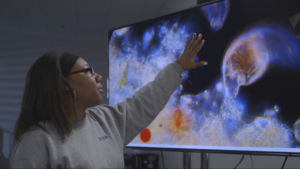Formed by Dr. Ricart in 2010 and announced at the White House on June 14, 2012, the organization brings together corporations, universities and federal agencies to develop applications and services designed for the next generation of the Internet.
These applications are meant to have a profound impact on the way Americans work, live, and learn. “We’re developing applications that take advantage of an Internet that is fast enough to be in sync with the real world,” Dr. Ricart said.

The technology is focused in six areas: healthcare, clean energy, transportation, education and workforce development, public safety, and advanced manufacturing. Applications are designed to be open and sharable, spurring business growth, the development of software-defined networks and ultra high-speed broadband.
The concept for US Ignite began when Thomas Kalil of the White House Office of Science and Technology Policy asked Dr. Ricart a relatively simple question: “What’s going to happen next with the Internet?”
“When Tom asked, I really didn’t know. So I talked to academics and corporations and others and eventually developed a point of view on what the next generation of the Internet might look like,” said Dr. Ricart. “Then we began to talk about some ways to make that vision happen.”
It quickly became clear “that no one would invest the funds to install and deploy a new ultrafast and ultra-responsive infrastructure without applications,” he said. “We would have to develop the applications first.”
Four years later, the applications are being designed around high-speed, low-latency networks with virtual capabilities to help bring them to life.
Examples include hospital-quality monitoring of the elderly aging-in-place at home, real-time power-grid monitoring, streaming virtual reality for education and a streaming 4K arts and sciences network.
Other applications include wearable sensors warning caregivers of potential asthma attacks in children and a weather-monitoring system that helps predict storms in coastal North Carolina.
Dr. Ricart insists people will need access to ultra-high-speed Internet in order for these applications to truly benefit the broader public. US Ignite is now taking a hard look at ways to make ultra-high-speed Internet a cost-effective infrastructure for carriers and cities alike to provide as basic infrastructure in forward-looking communities.
In the future, Dr. Ricart maintains, “the discussion will move from megabits and gigabits to milliseconds and microseconds. Speed is about how quickly something responds to you.”
“One of the things I think that will be transformational is streaming virtual reality,” he said. “Today, you can buy a $1,600 Oculus Rift. But most of that cost is in a dedicated computer you hook to the headset. Using a gigabit Internet, you could stream to a headset from your local library at a much lower cost. It will democratize access to virtual reality.”
Uses might extend to classroom teaching in classrooms and diagnosing patients. Virtual reality could also have a huge impact on public safety, Dr. Ricart noted.
“We can use information on dash cams to get better situational awareness at police and military command posts,” he added, using 3-D virtual reality to reconstruct scenes in real-time as has been done at Wayne State University.
Dr. Ricart pointed to students in Chattanooga, Tennessee, who, through high-speed, fiber-optic Internet, were able to control a digital-cinema microscope 2,000 miles away at the University of Southern California last year and see the results in ultra-HD in real-time. You can watch this amazing exchange here.
“They were able to use and focus this microscope across the country because the latency was so low,” he said. “This is a great harbinger of the opportunities for remote instrumentation and remote surgery.”
Read about Dr. Ricart’s historic contributions to the global Internet in this month’s Internet Hall of Fame profile.